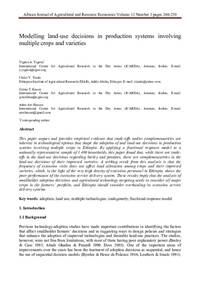Modelling land-use decisions in production systems involving multiple crops and varieties

Authors:
This paper argues and provides empirical evidence that trade-offs and/or complementarities are
inherent in technological options that shape the adoption of and land-use decisions in production
systems involving multiple crops in Ethiopia. By applying a fractional response model to a
nationally representative sample of 1 469 households, this paper found that, while there are tradeoffs
in the land-use decisions regarding barley and potatoes, there are complementarities in the
land-use decisions of their improved varieties. A striking result from this analysis is that the
frequency of extension visits does not affect land allocation among crops and their improved
varieties, which, in the light of the very high density of extension personnel in Ethiopia, shows the
poor performance of the extension service delivery system. These results imply that the analysis of
smallholder adoption decisions and agricultural technology targeting needs to consider all major
crops in the farmers’ portfolio, and Ethiopia should consider overhauling its extension service
delivery systems.
